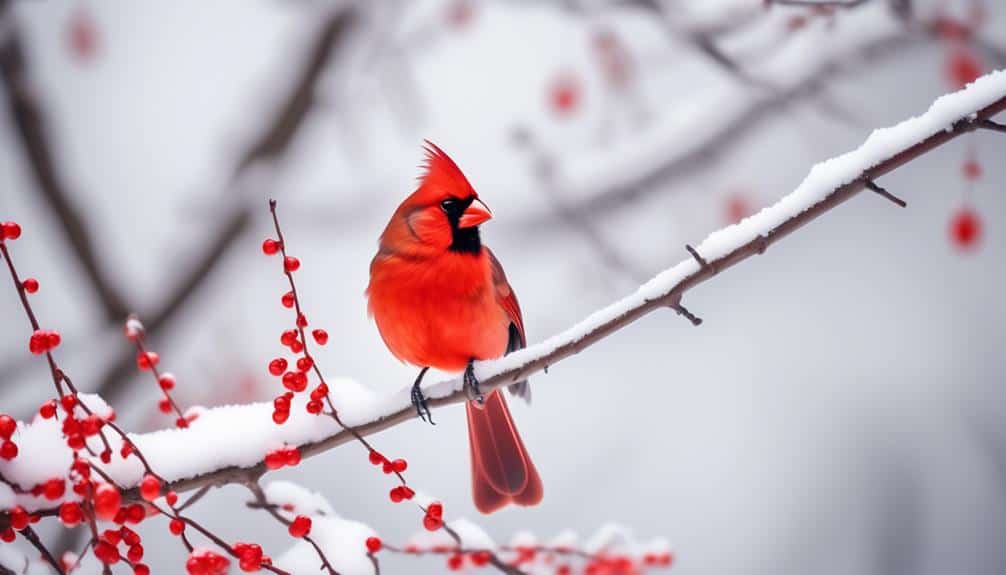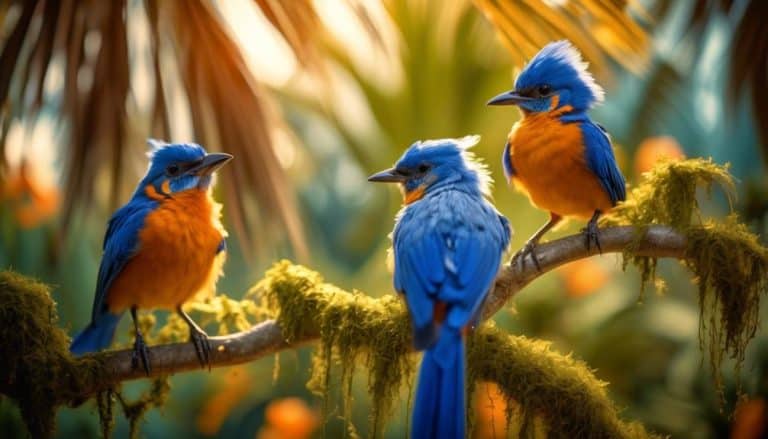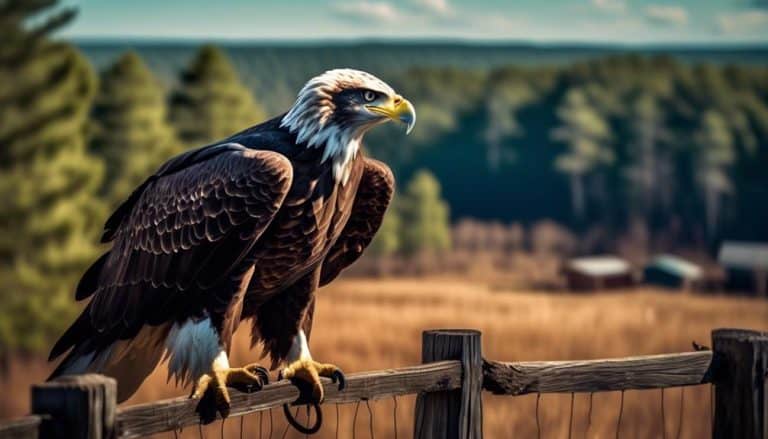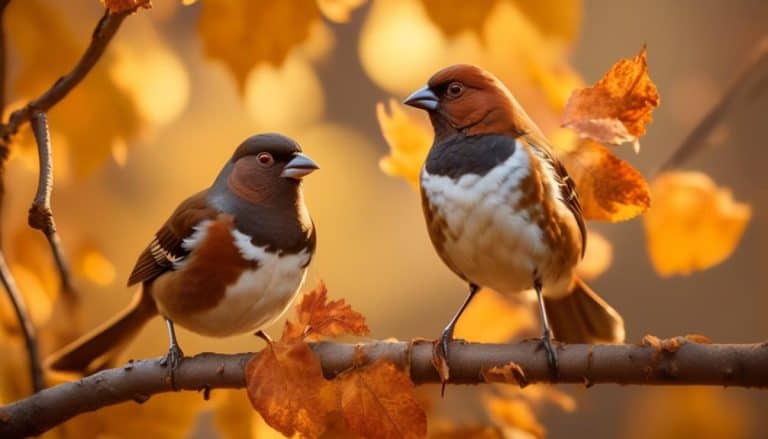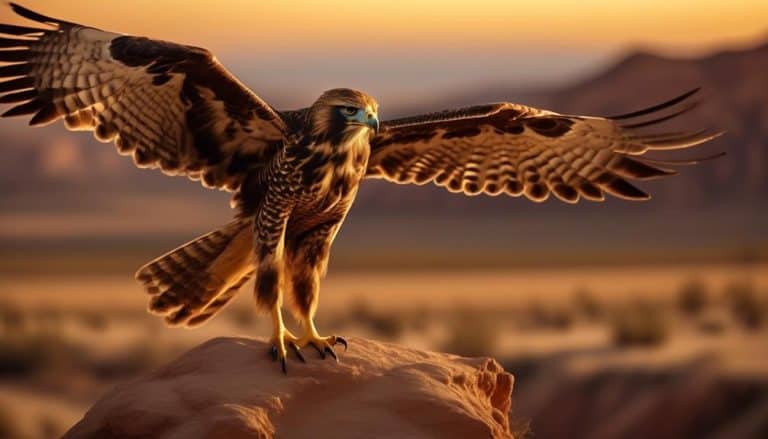Have you ever wondered about the vibrant red birds that grace the skies of Pennsylvania?
In this discussion, we will explore the fascinating world of these crimson-hued creatures that add a pop of color to our state.
From the iconic Cardinal to the elusive Summer Tanager, each species has its own unique characteristics and stories to tell.
So, join me as we uncover the secrets of these red birds and discover the unexpected surprises that await us in the Pennsylvanian wilderness.
The Cardinal: Pennsylvania's Iconic Red Bird
The cardinal, known scientifically as Cardinalis cardinalis, is the iconic red bird of Pennsylvania. It's a species of bird that's prevalent in the eastern and central parts of North America. The cardinal's habitat consists of a variety of environments, including woodlands, gardens, and thickets. They're often found in areas with dense vegetation, as this provides them with ample cover and a source of food.
In terms of diet, the cardinal is primarily a seed-eater. They consume a wide range of seeds, including those from grasses, weeds, and trees. Additionally, they also eat fruits and berries, particularly during the warmer months when these food sources are more readily available. The cardinal has a strong beak that's specifically adapted for cracking open seeds and extracting the nutritious contents.
Despite their preference for seeds, cardinals are also known to eat insects and other small invertebrates. This is especially true during the breeding season when they need a higher protein intake to support their growing offspring. They're skilled foragers and can often be seen hopping along the ground or perched on branches, searching for food.
The Scarlet Tanager: A Jewel in the Forest

Having explored the iconic red bird of Pennsylvania, the cardinal, it is now time to turn our attention to another stunning avian resident of the state's forests: the Scarlet Tanager. With its vibrant red plumage and jet-black wings, the Scarlet Tanager is truly a jewel in the forest.
| Migration Patterns | Diet and Habitat Preferences |
|---|---|
| The Scarlet Tanager | The Scarlet Tanager |
| exhibits a remarkable | primarily feeds on insects and |
| migratory behavior, | fruits, making it an insectivore |
| traveling long | and frugivore. During the |
| distances from its | breeding season, it can be |
| wintering grounds in | found in deciduous and mixed |
| South America to its | forests with a dense canopy, |
| breeding grounds in | where it builds its nest on high |
| the eastern United | branches. It prefers mature |
| States and Canada. | forests with a diverse range of |
| tree species. |
The Scarlet Tanager's migration patterns are awe-inspiring. These birds undertake a long journey from their wintering grounds in South America to their breeding grounds in the eastern United States and Canada. Their vibrant red plumage serves as a beacon, guiding them through the vast distances they cover.
In terms of diet, the Scarlet Tanager is an insectivore and frugivore. It primarily feeds on a variety of insects, including beetles, caterpillars, and flies. During the breeding season, it also consumes a considerable amount of fruits, such as berries and cherries. This diverse diet ensures that the Scarlet Tanager can find sustenance throughout its range.
When it comes to habitat preferences, the Scarlet Tanager favors deciduous and mixed forests with a dense canopy. These forests provide the necessary cover and nesting sites for the birds. They build their nests on high branches, hidden amongst the leaves. Mature forests with a diverse range of tree species offer the Scarlet Tanager a rich and abundant habitat.
The Summer Tanager: A Rare Visitor to Pennsylvania
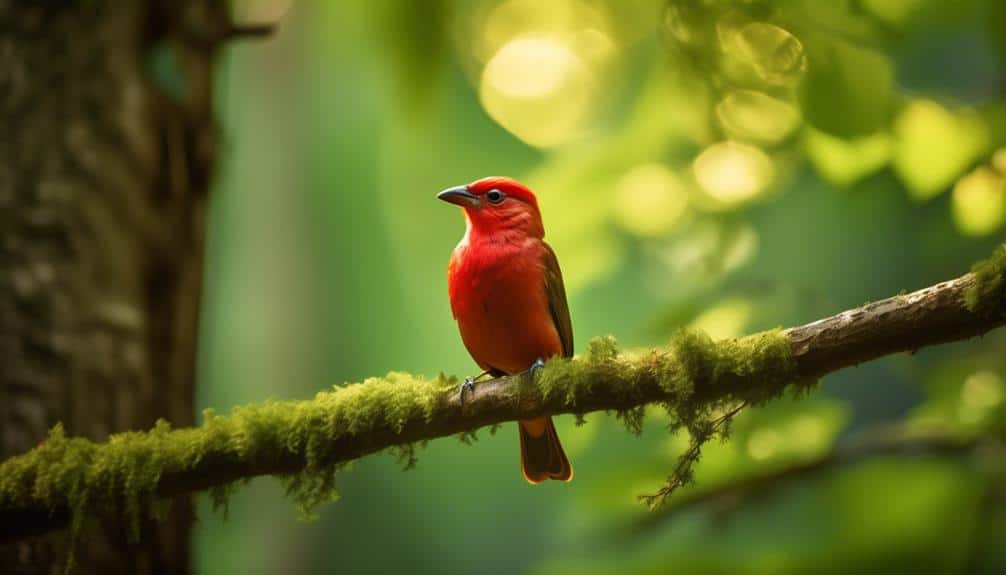
As a rare visitor to Pennsylvania, the Summer Tanager brings a splash of vibrant color to the state's forests. This species, Piranga rubra, is primarily found in the southeastern United States and Central America. However, occasionally, a few individuals deviate from their typical migratory patterns and venture northward, delighting birdwatchers with their presence.
The Summer Tanager is a medium-sized songbird, measuring around 7 to 8 inches in length. The males are known for their striking plumage, displaying a brilliant red coloration that contrasts with their dark wings and tail. The females, on the other hand, are more subdued, with a yellowish-green hue.
The occurrence of Summer Tanagers in Pennsylvania is considered a rare bird sighting, as their breeding range is typically confined to the southeastern states. During the breeding season, they prefer open woodlands, especially those with oak and pine trees. Their diet mainly consists of insects, which they catch while in flight or glean from the foliage.
Understanding the migratory patterns of the Summer Tanager is crucial for comprehending these rare visits to Pennsylvania. Most individuals undertake a long-distance migration to spend the winter months in Central and South America. However, a small number of individuals may deviate from this pattern and end up in unexpected locations, like Pennsylvania. The reasons behind these deviations are still not well understood, but they might be influenced by factors like weather conditions, competition for resources, or navigation errors.
The Vermilion Flycatcher: A Vibrant Flycatching Expert
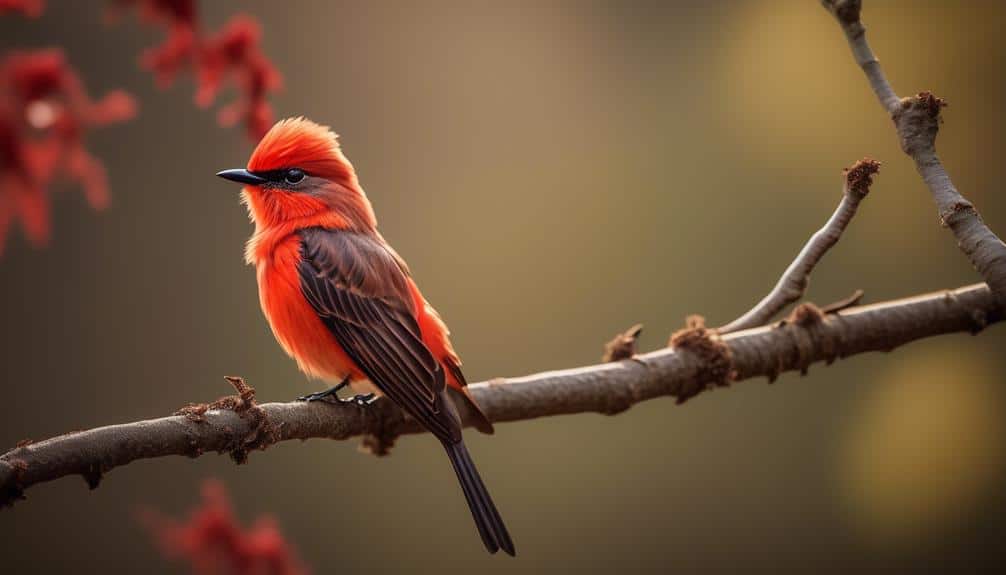
While the Summer Tanager occasionally brings a burst of red to Pennsylvania's forests, another vibrant bird, the Vermilion Flycatcher, showcases its flycatching expertise in equally stunning fashion. The vermilion flycatcher (Pyrocephalus rubinus) is a small bird found primarily in the southwestern United States, Mexico, and Central and South America. It is known for its striking plumage, with males displaying a brilliant vermilion color on their underparts and a contrasting black or dark brown on their upperparts.
The vermilion flycatcher is a migratory species, with populations in the United States and Mexico moving south during the winter months to find suitable feeding grounds and breeding sites. It prefers open areas such as grasslands, agricultural fields, and scrublands, where it can perch on prominent branches or wires to scan for flying insects. Its diet consists mainly of insects, which it catches in mid-air with its sharp beak and agile flight.
However, the vermilion flycatcher's habitat is under threat from climate change. Rising temperatures and changing precipitation patterns can disrupt the availability of food sources and nesting sites for these birds. Additionally, extreme weather events such as hurricanes and droughts can further impact their populations. Conservation efforts are crucial to protect the vermilion flycatcher and ensure the preservation of its unique beauty and flycatching expertise for future generations.
| Vermilion Flycatcher | |
|---|---|
| Kingdom | Animalia |
| Phylum | Chordata |
| Class | Aves |
| Order | Passeriformes |
The Northern Flicker: The Unexpected Red Bird of Pennsylvania
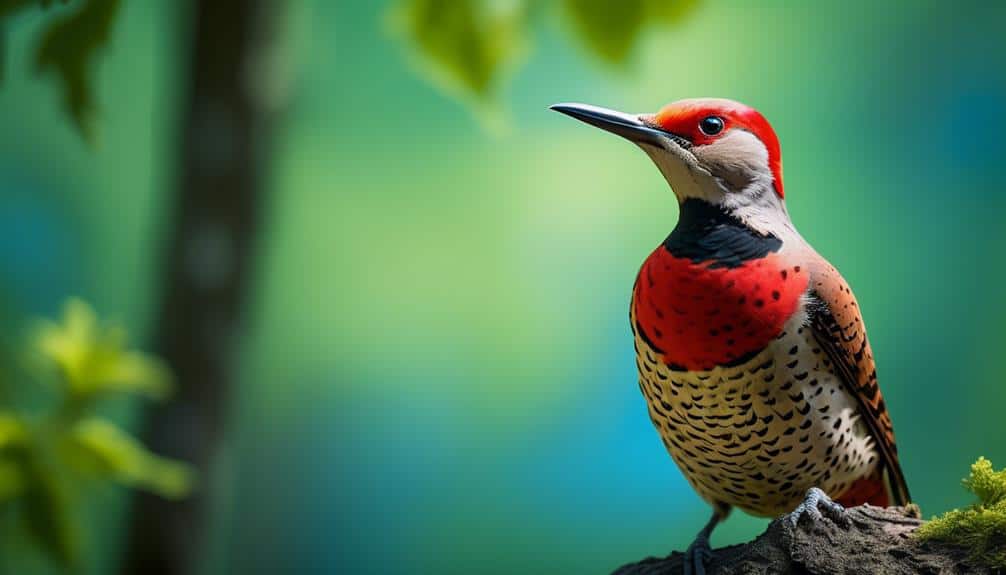
The Northern Flicker, a surprising red bird found in Pennsylvania, showcases its distinctive plumage and unique behaviors. Here are three fascinating aspects of the Northern Flicker:
- Unique Markings: The Northern Flicker is instantly recognizable by its striking plumage. Its body is primarily brown, with a black crescent on its chest and a bold red patch on the nape of its neck. The undersides of its wings and tail feathers are bright yellow. These distinctive markings make the Northern Flicker stand out among other birds in Pennsylvania.
- Behavior: The Northern Flicker is known for its interesting behaviors. It's a ground forager, often seen hopping on the ground in search of ants and beetles, which make up a significant part of its diet. Additionally, the Northern Flicker is an expert at drumming. It uses its stout bill to hammer on trees, creating rhythmic beats that reverberate through the forest, attracting mates and establishing territories.
- Habitat: The Northern Flicker can be found in a variety of habitats in Pennsylvania. It prefers open woodlands, forest edges, and areas with scattered trees. It also takes advantage of suburban areas with trees and open lawns. The Northern Flicker commonly nests in tree cavities, but it's also known to use birdhouses and even old woodpecker holes.
Frequently Asked Questions
How Many Species of Red Birds Can Be Found in Pennsylvania?
In Pennsylvania, the number of red bird species is influenced by red bird migration patterns and red bird population trends. It would be interesting to investigate how these factors contribute to the diversity of red birds in the state.
What Is the Average Lifespan of Red Birds in Pennsylvania?
On average, red birds in Pennsylvania enjoy a surprisingly long and fruitful life. Their lifespan surpasses all expectations, thanks to favorable environmental conditions and population trends that support their thriving existence.
Are Red Birds in Pennsylvania Migratory or Do They Stay Year-Round?
Red birds in Pennsylvania, also known as cardinals, can be found year-round. However, their population trends and behavior may be influenced by climate change. It is important to study the impact of climate change on these birds.
What Habitats Do Red Birds Prefer in Pennsylvania?
In Pennsylvania, red birds prefer habitats with dense foliage, such as forests and woodlands. They are attracted to areas with plenty of food sources like berries and insects. The red bird population in Pennsylvania is thriving.
How Can I Attract Red Birds to My Backyard in Pennsylvania?
To attract red birds to my backyard in Pennsylvania, I can use bird feeders. By providing a variety of seeds and fruits, I can create an enticing habitat that will draw these beautiful birds to my outdoor space.
Conclusion
In conclusion, Pennsylvania is home to an array of stunning red birds that add a vibrant splash of color to the state's natural beauty.
From the iconic Cardinal to the dazzling Scarlet Tanager, these feathered jewels bring life and wonder to the forests.
Even the rare visitor, the Summer Tanager, leaves a lasting impression with its vivid hues.
And let's not forget the unexpected Northern Flicker, a red bird that surprises and delights.
Pennsylvania truly offers a visual feast for bird enthusiasts.

